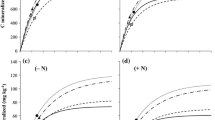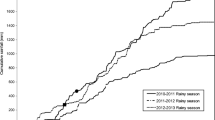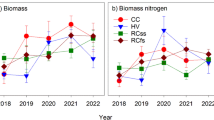Abstract
Shortened fallows have resulted in declining upland rice yields in slash-and-burn upland rice systems in northern Laos. We studied the benefit of planted legume fallows for rice productivity, weeds, and soil nitrogen and phosphorus availability. Four systems were evaluated over a 5-year period: 1-year fallow with native species, 1-year Cajanus cajan fallow, 1-year Leucaena leucocephala fallow, and continuous annual rice cropping. Rice was grown either once each year as continuous annual cropping or in alternate years of 2001, 2003, and 2005. C. cajan and L. leucocephala were sown with rice during the 2001 growing season. In subsequent years, L. leucocephala regenerated from root stock and did not have to be resown, whereas C. cajan was resown in 2003. Establishment of either C. cajan or L. leucocephala had no significant effect on rice yield in 2001, and rice yields ranged from 2.0 to 2.3 t/ha. Rice yields declined rapidly in succeeding years, and rice yields in the four systems ranged from 0.7 to 1.1 t/ha in 2003 and from 0.3 to 0.5 t/ha in 2005. Although two planted fallow systems increased nitrogen input because of greater biomass accumulation in 2003 and 2005 and soil phosphorus availability was higher following L. leucocephala fallow in 2005, there were no significant differences in rice yields among the four systems in either year. Weed biomass during the rice growing season increased each year in all systems and increased more rapidly for continuous annual rice cropping, in which the dominant weed species was Ageratum conyzoides L. Among the other three systems, there were no significant differences in the weed biomass in 2003 and 2005. We conclude that C. cajan and L. leucocephala as 1-year fallows do not offset the negative effects of increased cropping intensity on rice yield in this region.



Similar content being viewed by others
References
Akanvou R, Kropff MJ, Basitaans L et al (2002) Evaluating the use of two contrasting legume species as relay intercrop in upland rice cropping systems. Field Crops Res 76:23–36
Becker M, Johnson DE (1998) Legumes as dry season fallow in upland rice-based systems of West Africa. Biol Fertil Soils 27:358–367
Boehringer A, Caldwell R (1989) Cajanus cajan (L.) Millsp. as a potential agroforestry component in the Eastern Province of Zambia. Agroforest Syst 9:127–140
Cassman KG, Singleton PW, Linquist BA (1993) Input/output analysis of the cumulative soybean response to phosphorus on an Ultisol. Field Crops Res 34:23–36
Daniel JN, Ong CK (1990) Perennial pigeon pea; a multi-purpose species for agroforestry systems. Agroforest Syst 10:113–129
de Rouw A (1994) Effect of fire on soil, rice, weeds and forest regrowth in a rain forest zone (Côte d’Ivoire). CATENA 22:133–152
Fujisaka S (1991) A diagnostic survey of shifting cultivation in northern Laos: targeting research to improve sustainability and productivity. Agroforest Syst 13:95–109
Hidaka S (1997) Nitrogen. In: Committee for Standard Methods of Soil Analysis, Japanese Society of Soil Science and Plant Nutrition (eds) Standard method of soil environment analyses. Hakuyusha, Tokyo (in Japanese)
Kyuma K, Pairintra C (eds) (1983) Shifting cultivation. An experiment at Nam Phrom, northeast Thailand, its implications for upland farming in the monsoon tropics. Faculty of Agriculture, Kyoto University, Japan
Linquist B, Saito K, Keoboualapha B et al (2006) Improving upland rice-based cropping systems in Laos. In: Schiller JM, Chanphengxay MB, Linquist B, Appa Rao S (eds) Rice in Laos. International Rice Research Institute, Los Banõs, Philippines, pp 391–407
Nanjo M (1997) Available phosphate. In: Committee for Standard Methods of Soil Analysis, Japanese Society of Soil Science and Plant Nutrition (eds) Standard method of soil environment analyses. Hakuyusha, Tokyo (in Japanese)
National Statistical Center (2004) Statistical yearbook 2003. Vientiane
Roder W (2001) Slash-and-burn rice systems in the hills of northern Laos PDR: description, challenges, and opportunities. International Rice Research Institute, Los Baños
Roder W, Maniphone S (1995) Forage legume establishment in rice slash-and-burn systems. Trop Grasslands 29:81–87
Roder W, Maniphone S (1998) Shrubby legumes for fallow improvement in northern Laos: establishment, fallow biomass, weeds, rice yield, and soil properties. Agroforest Syst 39:291–303
Roder W, Phengchanh S, Keoboulapha B (1995) Relationships between soil, fallow period, weeds and rice yield in slash-and-burn systems of Laos. Plant Soil 176:27–36
Roder W, Phengchanh S, Keoboulapha B (1997a) Weeds in slash-and-burn rice fields in northern Laos. Weed Res 37:111–119
Roder W, Phengchanh S, Maniphone S (1997b) Dynamics of soil and vegetation during crop and fallow period in slash-and-burn fields of northern Laos. Geoderma 76:131–144
Roder W, Keoboulapha B, Phengchanh S et al (1998a) Effect of residue management and fallow length on weeds and rice yield. Weed Res 38:167–174
Roder W, Maniphone S, Keoboulapha B (1998b) Pigeon pea for fallow improvement in slash-and-burn systems in the hills of Laos. Agroforest Syst 39:45–57
Saito K, Linquist B, Keobualapha B et al (2006a) Cropping intensity and rainfall effects on upland rice yields in northern Laos. Plant Soil 284:175–185
Saito K, Linquist B, Keobualapha B et al (2006b) Stylosanthes guianensis as relay intercrop for improving the productivity of upland rice cropping systems in northern Laos. Field Crops Res 96:438–447
Saito K, Atlin GN, Linquist B et al (2007) Performance of traditional and improved upland rice cultivars under nonfertilized and fertilized conditions in northern Laos. Crop Sci 47:2473–2481
Troesch K (2003) Highland rice paddy development in mountainous regions of northern Lao PDR. Draft report. Swiss College of Agriculture
van Keer K, Trébuil G, Gozé E (2000) Identifying and grading limiting factors of upland rice yields in farmers’ fields of northern Thailand. Int Rice Res Notes 25:31–33
Acknowledgements
The research was partly funded by the Swiss Agency for Development and Cooperation (SDC) and the “Global Environment Research Fund,” The Ministry of the Environment, Government of Japan (Project S2-3b). The authors would like to gratefully acknowledge the support and help they received from the staff at the Northern Regional Agriculture and Forestry Research Center. We are also grateful for the identification of weed species of Mr. Joel Janiya, the editorial advice of Mr. Bill Hardy, and the comments of the two anonymous reviewers.
Author information
Authors and Affiliations
Corresponding author
Rights and permissions
About this article
Cite this article
Saito, K., Linquist, B., Johnson, D.E. et al. Planted legume fallows reduce weeds and increase soil N and P contents but not upland rice yields. Agroforest Syst 74, 63–72 (2008). https://doi.org/10.1007/s10457-008-9149-y
Received:
Accepted:
Published:
Issue Date:
DOI: https://doi.org/10.1007/s10457-008-9149-y




